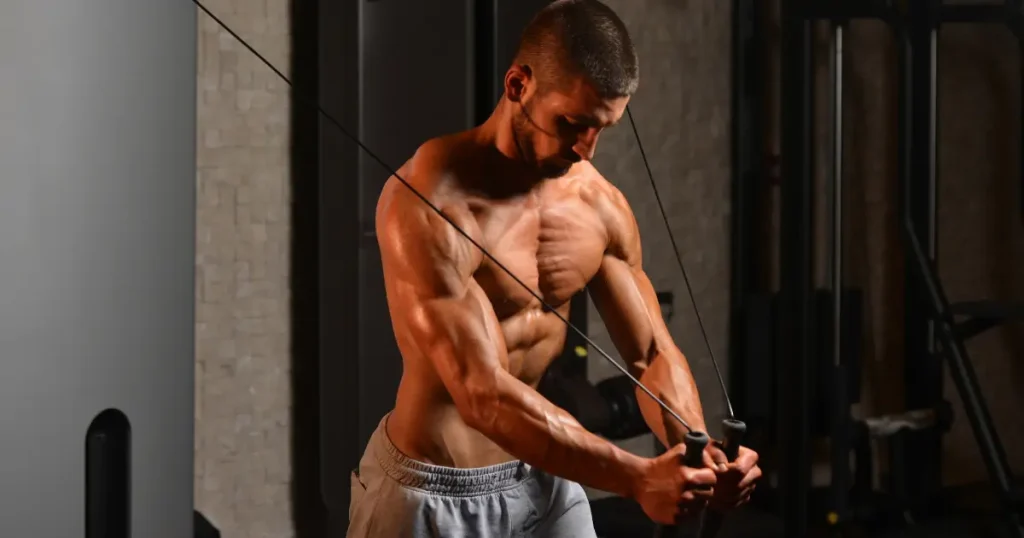bodybuilding & Fitness
Enhancing the chest musculature
For those who are new to chest strengthening exercises, it is advisable to seek the guidance of a trainer to guarantee that they adhere to a well-designed program and retain proper form during the exercises.
In addition, it may be beneficial to begin with a lighter weight in order to mitigate the risk of injury.
Push-up exercises strengthen the pectoral muscles.
Push-ups are a method of developing muscle. It enhances the strength of your core, biceps, and shoulders. The exercise necessitates the completion of the subsequent stages:
Maintain a straight back, ensure that your neck is in alignment with your spine, and keep your elbows near your sides.
To perform a barbell push-up, follow these steps:
- Sit on a barbell bench with your feet firmly anchored on the floor and your back flat.
- Position the barbell precisely above your eyes, and then position your head, shoulders, and buttocks on the bench.
- As you maintain the barbell in a forward position, wrap your forefinger around the bar.
- Place the bar above your jawline or upper torso, ensuring that your elbows and wrists remain straight.
- Inhale and progressively lower the bar until it reaches your chest beneath your armpits.
- As you exhale and squeeze the bar, keep your spine and wrists flat.
- To apply pressure, use iron instruments. The independent activity required on each side of the body when using weights activates accessory stabilizer muscles.
- Compared to dumbbells, dumbbells offer a wider range of motion at both the bottom and top of the movement.
Boosting the individual’s self-assurance muscles.

The primary concern of a bodybuilder is their self-confidence. If he persists in exercising his muscles, particularly the pectoral muscle, and fails to observe any discernible increase in their size, this is sufficient to erode his self-assurance.
Improve muscle strength in order to carry heavy loads. An increase in pectoral muscle mass improves upper body stability.
This, in turn, enhances the bodybuilder’s ability to lift heavier weights in other exercises, such as shoulder exercises and certain back exercises, as the chest muscle is responsible for connecting all sections of the upper body.
Concentrate on the pectoral muscles’ development.
Naturally, the primary objective of any bodybuilder is to maximize muscle mass. To achieve a high growth rate, one must implement five actions:
Initially, the training process implements the principle of progressive weight gain. It is imperative to begin with a weight that is consistent with one’s physical capabilities.As a result, you will gradually increase the weight whenever you perceive that you are not exerting as much effort as you did at the outset of the exercise with this weight.
it is important to periodically assess your weight. Establish your own schedule and record the weights of each exercise. As a result, you can monitor your progress and compile a weight inventory.
Fourth: As previously stated, muscle rest is an essential component of muscle growth and the completion of the muscle recovery process prior to conducting the subsequent exercise, particularly with large muscles like the pectoral muscle.
It is imperative to strengthen the pectoral muscles in order to execute the butterfly exercise correctly.
We should replace the term “correct method” with the most critical advice that will enable you to execute this exercise with the utmost proficiency. The following steps explain how to strengthen the chest:
Positive Movement:
In order to optimize the benefits of exercise, it is necessary to maintain movement discipline for a specific duration during positive training.
Weight selection: Choose a weight that is manageable and does not interfere with the correct execution of the exercise to strengthen the chest..
The butterfly exercise has the potential to enhance the strength of the pectoral muscles.
Numerous advantages are inherent in this exercise.
The following summary will now outline the butterfly chest exercise’s most significant advantages:
- Strengthening the chest muscles: This exercise directly improves the muscle fibers’ ability to bear weights, particularly when performed in accordance with the Progressive Overload system, which involves an incremental increase in the training load.
- Increasing pectoral size: This exercise also performs one of its fundamental functions by promoting an increase in muscle size and achieving the desired full shape.This exercise improves muscle balance by separating each muscle from the others.
- Enhancing functional strength: The capacity to execute daily tasks that necessitate pushing is not the only benefit of strengthening the chest muscles through any exercise.
- Stable muscle activation: This exercise involves activating the static muscles to aid in movement support and body stabilization.
- Exercise variety: You have the option of performing pectoral exercises with either dumbbells or a device. It is also possible to concentrate on the upper, middle, or lower pectoral fibers individually. This provides a diverse array of training methodologies.

